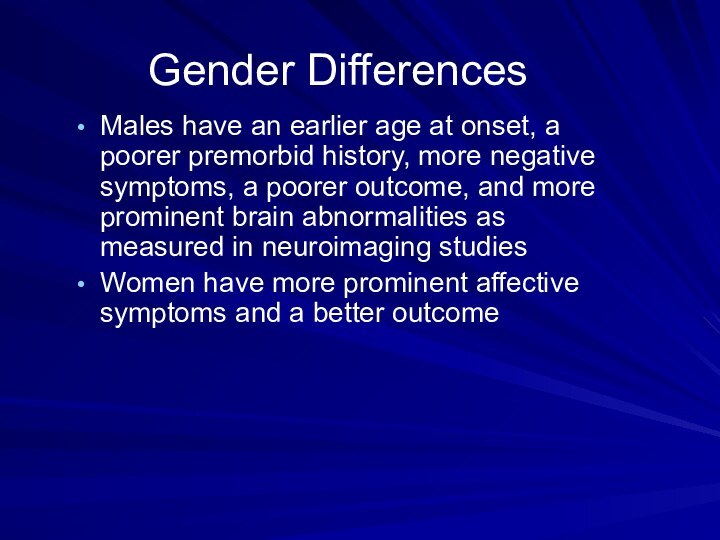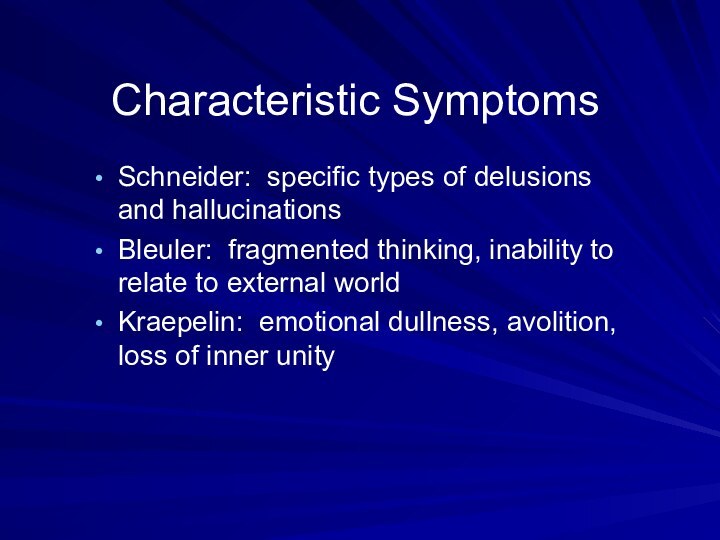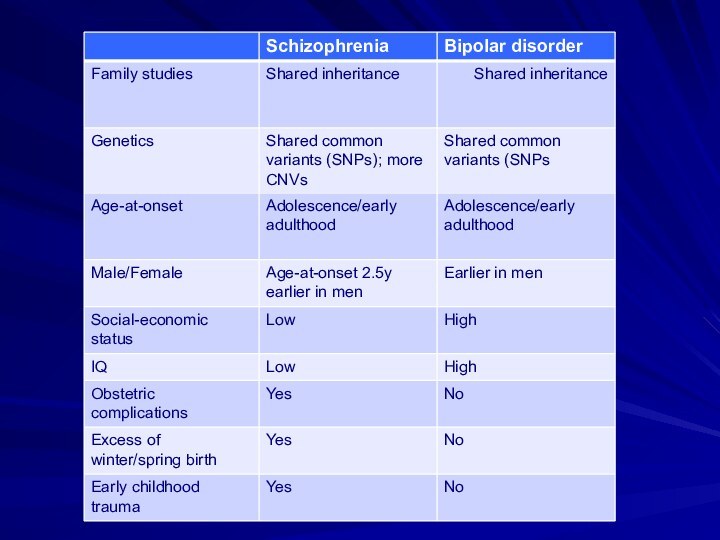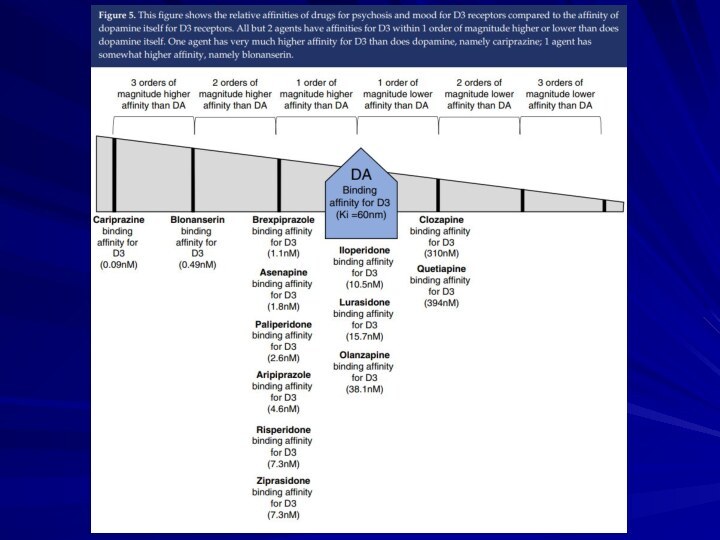- Главная
- Разное
- Бизнес и предпринимательство
- Образование
- Развлечения
- Государство
- Спорт
- Графика
- Культурология
- Еда и кулинария
- Лингвистика
- Религиоведение
- Черчение
- Физкультура
- ИЗО
- Психология
- Социология
- Английский язык
- Астрономия
- Алгебра
- Биология
- География
- Геометрия
- Детские презентации
- Информатика
- История
- Литература
- Маркетинг
- Математика
- Медицина
- Менеджмент
- Музыка
- МХК
- Немецкий язык
- ОБЖ
- Обществознание
- Окружающий мир
- Педагогика
- Русский язык
- Технология
- Физика
- Философия
- Химия
- Шаблоны, картинки для презентаций
- Экология
- Экономика
- Юриспруденция
Что такое findslide.org?
FindSlide.org - это сайт презентаций, докладов, шаблонов в формате PowerPoint.
Обратная связь
Email: Нажмите что бы посмотреть
Презентация на тему Schizophrenia. Environmental factors
Содержание
- 3. Environmental factors
- 4. Age of onset and peak of mental disordersNat Rev Neurosci (2), & 2008
- 6. Schizophrenia: inheritance
- 7. Manhattan plot showing schizophrenia associations S Ripke et al. Nature 1-7 (2014)
- 8. Subdivision of Symptoms into Three DimensionsPsychoticDelusionsHallucinationsDisorganizedDisorganized speechDisorganized behaviorInappropriate affectNegativePoverty of speechAvolitionAffective BluntingAnhedonia
- 9. Types of HallucinationsAuditoryVisualTactileOlfactory
- 10. Types of Delusions PersecutoryGrandioseReligiousJealousSomatic
- 11. DSM-5 Criteria for Schizophrenia: The BasicsCharacteristic symptoms
- 12. Differential DiagnosisMood DisordersNonpsychotic personality disordersSubstance-induced psychotic disordersPsychotic
- 13. Drugs That May Induce PsychosisAmphetaminesMarijuanaHallucinogensCocaineCannabis
- 14. Medical Conditions That May Present with PsychosisTemporal lobe epilepsyTumorStrokeTraumaEndocrine/metabolic abnormalitiesInfectionsMultiple SclerosisAutoimmune diseases
- 15. The Dopamine HypothesisPsychosis (schizophrenia?) is due to
- 16. Copyright restrictions may apply.Howes, O. D. et
- 19. Brain Regions Showing Replicable Neuropathological Abnormalities Temporolimbic regionsThalamusPrefrontal cortex
- 20. Neuropil in Frontal Cortex
- 22. Criterion A: Characteristic SymptomsAt least two of
- 23. Gender DifferencesMales have an earlier age at
- 24. Important Epidemiolgical ObservationsPrevalence is not highly variable
- 25. Bleuler’s Fundamental SymptomsAssociationsAffective BluntingAvolitionAutismAmbivalenceAttention
- 26. Schneider: The Psychotic ExperienceInterested in pathognomonic symptoms“First
- 27. Characteristic SymptomsSchneider: specific types of delusions and
- 28. Criterion B: Social/Occupational DysfunctionFor a significant portion
- 29. Criterion C: Overall DurationContinuous signs of the
- 30. Criterion D: Schizoaffective and Mood Disorder ExclusionSchizoaffective
- 31. Criterion E: Substance / General Medical Condition
- 32. DSM 5: Categories of PsychosisSchizophreniform DisorderSchizophreniaBrief Psychotic
- 33. Poor Outcome: PredictorsProminent negative symptomsEarly age of
- 35. Lower Social Class in SchizophreniaConsistently observed in
- 36. Genetic QuestionsIs the disorder familial?Relative contributions of
- 37. Genetic MethodsFamily history studiesFamily studiesTwin studiesAdoption studiesLinkage and association studies, candidate genesMolecular genetics—functional genomics, proteomics
- 38. Manhattan plot showing schizophrenia associations S Ripke et al. Nature 1-7 (2014)
- 39. Family History and Family StudiesProvide evidence for
- 40. Possible Reasons for Lack of Measurable Abnormalities
- 41. Hippocampal Atrophy in SchizophreniaPatientsControls
- 42. Thalamic Nuclei
- 43. A Neurodevelopmental Disorder: Supporting Evidence from NeuropathologyAbsence
- 44. Classified ImagesContinuousDiscrete
- 45. MR Studies: Brain AbnormalitiesDecreased temporal lobe sizeDecreased
- 46. A Neurodevelopmental Brain DiseaseMost brain abnormalities
- 47. Increased Blood Flow in Striatum due to Chronic Dopamine Blockade by Haloperidol
- 48. Functional Imaging ToolsSingle Photon Emission Computed Tomography (SPECT)Positron Emission Tomography (PET)Functional Magnetic Resonance (fMR)
- 49. Conclusions from PET StudiesSchizophrenia is not a
- 50. The fMR Blood Flow Signal
- 51. Verbal FluencyPatientsControls
- 52. The N-Back Task for fMRProbexxTargetExperimental Task (2-Back):
- 53. 2-Back Task in NormalsBilateral dorsolateral frontalBilateral parietalAnterior cingulate
- 54. 2-Back Task in Schizophrenia (unmedicated)Blood flow markedly
- 55. Sensory GatingA problem in filtering or gating
- 56. Cognitive DysmetriaA defect in coordinating mental activityDue
- 58. Simplified Summary of Various Anatomical
- 59. Copyright restrictions may apply.Howes, O. D. et
- 60. Multiple hits interact to result in (1)
- 63. The Essence of SchizophreniaOriginally called “dementia praecox”Produces severe incapacity – “dementia”Typically begins in adolescence – “praecox”
- 64. Kraepelin: Course and OutcomeSplit “dementia praecox” from
- 65. Fundamental Questions about SchizophreniaWhat are the characteristic
- 66. Lifetime PrevalenceWhat proportion of the population will
- 73. Скачать презентацию
- 74. Похожие презентации
Environmental factors









































































Слайд 8
Subdivision of Symptoms into Three Dimensions
Psychotic
Delusions
Hallucinations
Disorganized
Disorganized speech
Disorganized behavior
Inappropriate
affect
Negative
Poverty of speech
Avolition
Affective Blunting
Anhedonia
Слайд 11
DSM-5 Criteria for Schizophrenia: The Basics
Characteristic symptoms for
one month
Social/Occupational Dysfunction
Overall Duration > 6 months
Not attributable to
mood disorderNot attributable to substance use or general medical condition
Слайд 12
Differential Diagnosis
Mood Disorders
Nonpsychotic personality disorders
Substance-induced psychotic disorders
Psychotic disorders
due to a general medical condition (i.e., “organic” disorders)
Слайд 14
Medical Conditions That May Present with Psychosis
Temporal lobe
epilepsy
Tumor
Stroke
Trauma
Endocrine/metabolic abnormalities
Infections
Multiple Sclerosis
Autoimmune diseases
Слайд 15
The Dopamine Hypothesis
Psychosis (schizophrenia?) is due to excessive
dopaminergic tone
Psychotic symptoms are relieved by blockade of dopamine
receptors with neuroleptic medications
Слайд 16
Copyright restrictions may apply.
Howes, O. D. et al.
Arch Gen Psychiatry 2012;0:archgenpsychiatry.2012.169v1-11.
Schematic diagram summarizing the findings from
our meta-analyses of dopamine function in schizophrenia
Слайд 19
Brain Regions Showing Replicable Neuropathological Abnormalities
Temporolimbic regions
Thalamus
Prefrontal
cortex
Слайд 22
Criterion A: Characteristic Symptoms
At least two of the
following, each present for a significant portion of time
during a one month period (or less if successfully treated):(1) delusions
(2) hallucinations
(3) disorganized speech (e.g., frequent derailment or incoherence)
(4) grossly disorganized or catatonic behavior
(5) negative symptoms, I.e., affective flattening, alogia, or avolition
Слайд 23
Gender Differences
Males have an earlier age at onset,
a poorer premorbid history, more negative symptoms, a poorer
outcome, and more prominent brain abnormalities as measured in neuroimaging studiesWomen have more prominent affective symptoms and a better outcome
Слайд 24
Important Epidemiolgical Observations
Prevalence is not highly variable over
time or over geographical areas
Found in all cultures
More common
and/or severe in males than femalesPersists in the population despite decreased fertility
Слайд 25
Bleuler’s Fundamental Symptoms
Associations
Affective Blunting
Avolition
Autism
Ambivalence
Attention
Слайд 26
Schneider: The Psychotic Experience
Interested in pathognomonic symptoms
“First Rank
Symptoms” (FRS)
E.g., voices commenting
Voices arguing
Thought insertion
Involve a loss of
the sense of autonomy of self, or “ego boundaries”
Слайд 27
Characteristic Symptoms
Schneider: specific types of delusions and hallucinations
Bleuler:
fragmented thinking, inability to relate to external world
Kraepelin: emotional
dullness, avolition, loss of inner unity
Слайд 28
Criterion B: Social/Occupational Dysfunction
For a significant portion of
the time since the onset of the disturbance, one
or more major areas of functioning such as work, interpersonal relations or self-care is markedly below the level achieved prior to the onsetOR when the onset is in childhood or adolescence, failure to achieve expected level of interpersonal, academic, or occupational achievement
Слайд 29
Criterion C: Overall Duration
Continuous signs of the disturbance
persist for at least six months
This six-month period must
include at least one month of symptoms that meet criterion A (i.e., active phase symptoms), and may include periods of prodromal or residual symptomsDuring these prodromal or residual period, the signs of the disturbance may be manifested by only negative symptoms or two or more symptoms listed in criterion A present in an attenuated form (e.g. odd beliefs, unusual perceptual experiences)
Слайд 30
Criterion D: Schizoaffective and Mood Disorder Exclusion
Schizoaffective Disorder
and Mood Disorder with Psychotic Features have been ruled
out because of either:No major depressive or manic episodes have occurred concurrently with the active phase symptoms; or
If mood episodes have occurred during active phase symptoms, their total duration has been brief relative to the duration of the active and residual periods
Слайд 31
Criterion E: Substance / General Medical Condition Exclusion
The
disturbance is not due to the direct effects of
a substance (e.g., drugs of abuse, medication) or a general medical condition
Слайд 32
DSM 5: Categories of Psychosis
Schizophreniform Disorder
Schizophrenia
Brief Psychotic Disorder
Schizoaffective
Disorder
Delusional Disorder
Shared Psychotic Disorder
Psychotic Disorder due to a General
Medical ConditionSubstance-Induced Psychotic Disorder
Psychotic Disorder Not Otherwise Specified
Слайд 33
Poor Outcome: Predictors
Prominent negative symptoms
Early age of onset
Insidious
onset
Poor premorbid adjustment
Low educational achievement
Low parental social class
Male gender
Слайд 35
Lower Social Class in Schizophrenia
Consistently observed in patients
Lower
social class is a result—not a cause—of the illness
Social
class of parents does not differ from the general populationLower social class is due to “downward drift,” not to social deprivation, poor nutrition, or inadequate access to health care
Слайд 36
Genetic Questions
Is the disorder familial?
Relative contributions of genes
and environment
Mode of transmission
Location of gene
Function and products of
geneRole of the products in illness mechanisms
Слайд 37
Genetic Methods
Family history studies
Family studies
Twin studies
Adoption studies
Linkage and
association studies, candidate genes
Molecular genetics—functional genomics, proteomics
Слайд 39
Family History and Family Studies
Provide evidence for a
modest level of familial transmission
Morbid risk for parents: 5.6%
Morbid
risk for siblings: 10.1%Morbid risk for offspring: 12.8%
Second degree relatives: 2.4-4.2%
Слайд 40
Possible Reasons for Lack of Measurable Abnormalities
Problems
in defining the phenotype
No single pathophysiology
Due to reversible neurochemical
processesNot accessible using traditional neuropathology tools
In areas where neuropathologists have not yet looked
Due to abnormalities in connectivity
Слайд 43
A Neurodevelopmental Disorder: Supporting Evidence from Neuropathology
Absence of
gliosis
Abnormal cytoarchitecture
Visible markers of neurodevelopmental abnormalities such as cavum
septi pellucidi
Слайд 45
MR Studies: Brain Abnormalities
Decreased temporal lobe size
Decreased frontal
lobe size
Decreased hippocampal size
Decreased thalamic size
Gyral decreases (superior temporal
gyrus, ventral frontal gyri)General and regional decreases in gray matter volume
Слайд 46
A Neurodevelopmental Brain Disease
Most brain abnormalities are present
at onset: e.g., decrease in total brain tissue
Occasional evidence
of defects in neuronal migration: gray matter heterotopiasMidline abnormalities: cavum septi pellucidi, dysgenesis of the corpus callosum, ventricular enlargement
Слайд 48
Functional Imaging Tools
Single Photon Emission Computed Tomography (SPECT)
Positron
Emission Tomography (PET)
Functional Magnetic Resonance (fMR)
Слайд 49
Conclusions from PET Studies
Schizophrenia is not a disease
of a single brain region
Areas of abnormality vary depending
on the task and the nature of current symptomsSchizophrenia affects distributed circuitry throughout the brain
Слайд 52
The N-Back Task for fMR
Probe
x
x
Target
Experimental Task (2-Back): Remember
the Probe and Monitor for It
Comparison Task: Look for
the SS
A
B
C
D
E
Target
L
G
K
A
Look for the S
2-Back Task
Слайд 54
2-Back Task in Schizophrenia (unmedicated)
Blood flow markedly decreased
or absent in regions used by normals
Main activation is
anterior cingulate
Слайд 55
Sensory Gating
A problem in filtering or gating information
Leads
to the subject experience of being bombarded by stimuli
Explains
most symptoms—e.g., confusion of internal and external stimuli would cause delusions and hallucinationsSupported by neurophysiological studies of prepulse inhibition
Слайд 56
Cognitive Dysmetria
A defect in coordinating mental activity
Due to
disturbed functional connectivity between the cortex and subcortical regions
(thalamus and cerebellum)Leads to functional and cognitive misconnections
Explains diversity of symptoms (e.g., misconnecting a perception and its meaning might lead to delusions and hallucinations)
Supported by functional imaging studies
Слайд 58 Simplified Summary of Various Anatomical Refinements
of the Dopamine Hypotheses of Schizophrenia
Laruelle,
Biol psychiatry 2013;74:80–81AST, associative striatum; DA, dopamine; DLPFC, dorsolateral prefrontal cortex; VST, ventral striatum
Слайд 59
Copyright restrictions may apply.
Howes, O. D. et al.
Arch Gen Psychiatry 2012;0:archgenpsychiatry.2012.169v1-11.
Schematic diagram summarizing the findings from
our meta-analyses of dopamine function in schizophrenia
Слайд 60
Multiple hits interact to result in (1) striatal
dopamine dysregulation to alter (2) the appraisal of stimuli
and resulting in psychosis, whilst current antipsychotic drugs (3) act downstream of the primary dopaminergic dysregulation.
Слайд 63
The Essence of Schizophrenia
Originally called “dementia praecox”
Produces severe
incapacity – “dementia”
Typically begins in adolescence – “praecox”
Слайд 64
Kraepelin: Course and Outcome
Split “dementia praecox” from manic-depressive
illness
Early onset
Marked deterioration
Chronic course
Diversity of signs and symptoms
Importance of
volition and affect
Слайд 65
Fundamental Questions about Schizophrenia
What are the characteristic symptoms?
What
are the boundaries of the concept?
Is the disorder a
single illness or multiple disorders?If multiple, what are the subtypes?
Слайд 66
Lifetime Prevalence
What proportion of the population will develop
the disorder at some time during their lifetime?
Perhaps the
most important statistic for schizophrenia because of its inherent chronicityPrevalence 0.30-0.66% - narrow diagnostic category of schizophrenia
Prevalence 2.3% - schizophrenia and related psychoses (e.g., delusional, catch-all category of NOS)
Prevalence 3.5% - broader category of psychotic disorders including schizophrenia and related disorders, substance-induced psychotic disorders and bipolar disorder





























